10 Rarest Electric Guitars in the World. It’s no secret that electric guitars are among the most sought-after and expensive instruments in the world of music.
The notoriety of the performer who previously possessed an electric guitar can frequently have a significant impact on the instrument’s market value.
Because of this, many of these guitars are extremely uncommon, not because of how many copies they were made, but because of their unique histories.
In order to compile this list, we decided to center our attention on electric guitars that are so uncommon that only a small number of copies were ever sold during their first production run. In addition to being an extremely uncommon electric guitar, it also features some prototypes.
1. 1959 Gibson Les Paul Standard (Original Series)
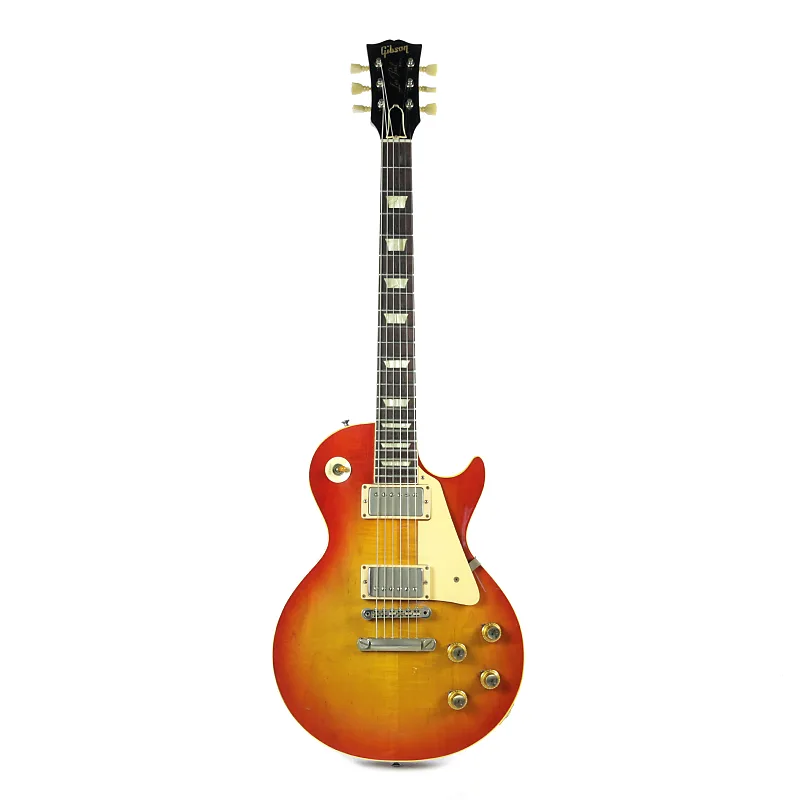
- Number Made: 1,700
- Value (Based on Highest Price Ever Paid at Auction): $237,000
- Manufacturer: Gibson
- Year Produced: 1959
The sunburst-finish Gibson Les Paul Standard from 1959 is widely regarded as one of the most iconic examples of an electric guitar ever created.
It was manufactured by Gibson. On the other hand, this wasn’t always the case, and the Gibson Les Paul Standard wasn’t all that popular when it was originally introduced.
It wasn’t until several great guitarists, including Jimmy Page, Eric Clapton, and Keith Richards, started playing this electric guitar that the Les Paul Standard shot to the top of the charts in terms of popularity.
During the initial run of the Gibson Les Paul Standard line in 1959, the company produced only roughly 1,700 of these guitars.
Any Les Paul Standard from that year is now extremely hard to find and fetches a high price. Two hundred thirty-seven thousand dollars was the highest price ever paid for a 1959 Gibson Les Paul Standard.
2. 1951 Les Paul Fender “NoCaster”
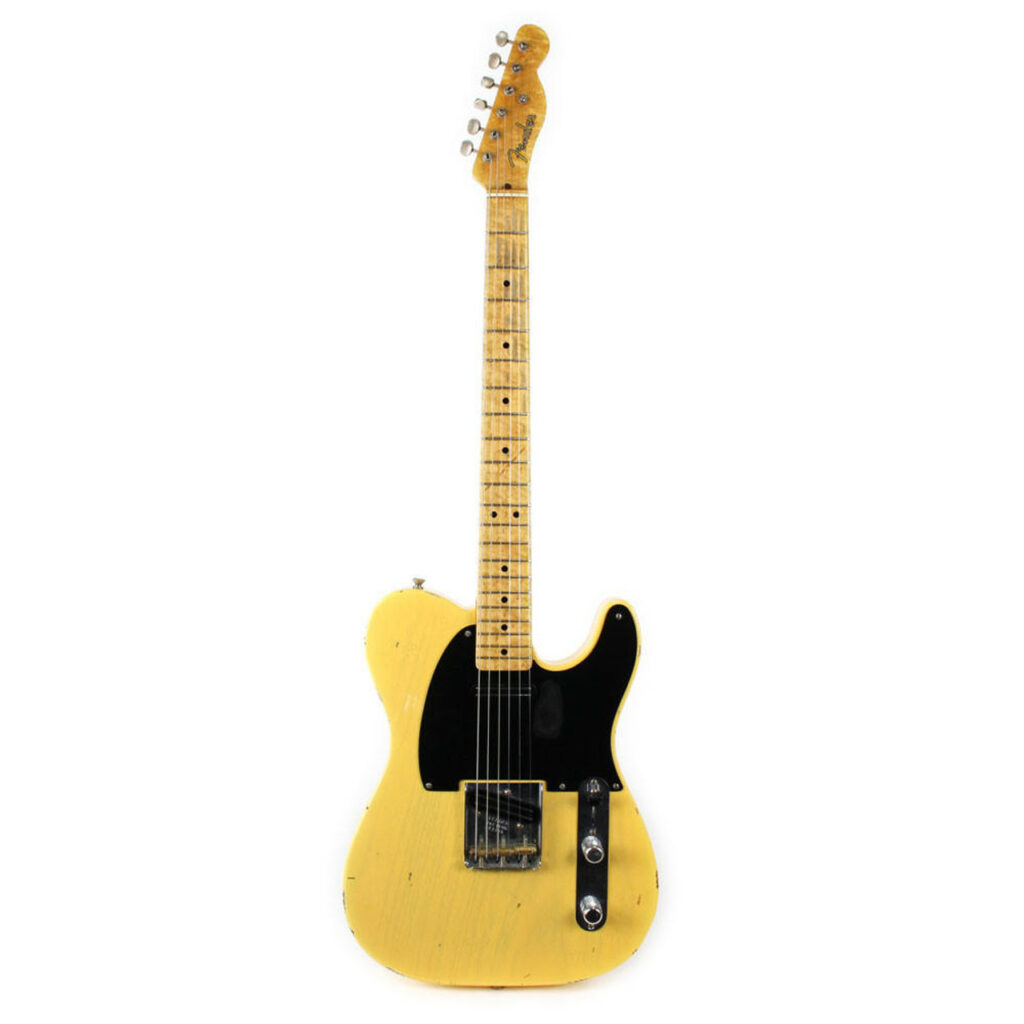
- Number Made: about 475
- $225,000
- Manufacturer: Fender
- Year Produced: 1951
The “NoCaster” electric guitar that was manufactured by Fender in 1951 has an interesting backstory.
The NoCaster was the predecessor to the Fender Telecaster, which went on to become the most successful solid-body electric guitar in the history of the instrument.
During the first production run in 1950, these extremely rare electric guitars were given the name “Broadcaster” at first.
After receiving a request from the Gretsch Company, which sold a drum set with the name “Broadkaster,” Fender made the decision the next year to remove all of the Broadcaster emblems from the remaining guitars in their inventory.
Only the Fender emblem appeared on guitars that were sold during the 1951 calendar year up until the latter half of that year, when the guitars were given their new moniker, Telecaster.
Only roughly 475 Fender NoCaster guitars were ever made, and in 2012, one of them fetched a price of $225,000 at auction.
3. 1959 Gibson Flying V
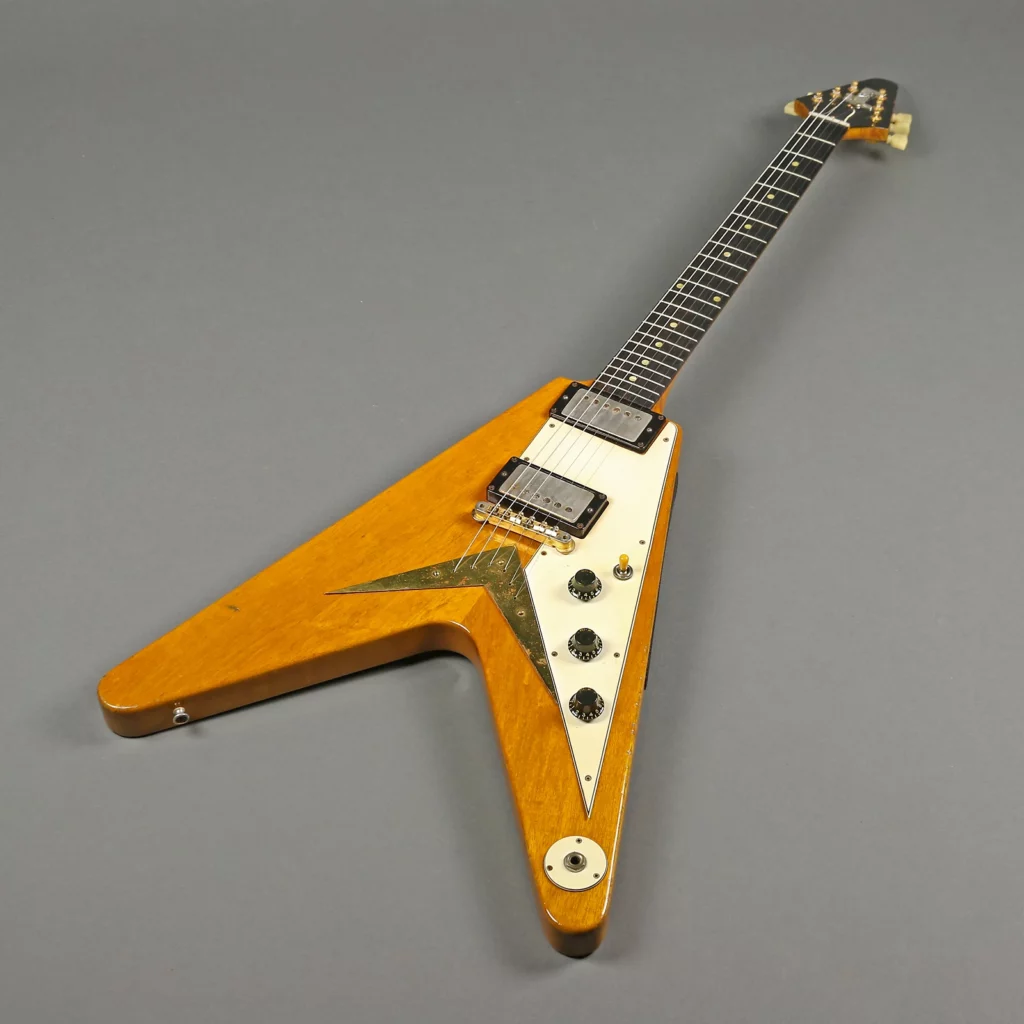
- Number Made: 98
- $182,500
- Manufacturer: Gibson
- Year Produced: 1959
After its initial debut in 1958, the Gibson Flying V was a guitar that did not fare well with consumers. Only 81 Flying Vs were produced in 1958, while 17 were sold in 1959, bringing the total number of Flying Vs sold to 98.
By the year 1960, the Gibson Flying V had reached the end of its initial production run. Because there were so few Gibson Flying Vs ever produced, there are not very many still in existence today.
A 1959 Gibson Flying V sold in 2009 for $182,500, which is significantly higher than the average selling price of a Flying V in pristine condition, which is generally over $100,000.
J. Levine’s Auction & Appraisal in Scottsdale, Arizona claims that the Gibson Flying V was unsuccessful due to the fact that its design “was too radical for the people of the era.”
4. 1949 Bigsby Birdseye Maple Solid Body
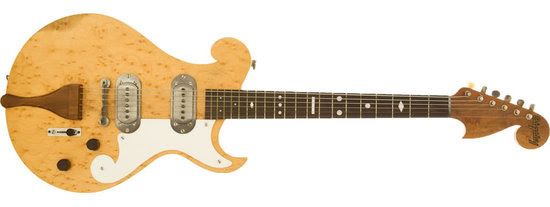
- Number Made: 23
- $266,000
- Manufacturer: Bigsby
- Year Produced: 1949
At an auction in 2012, one of the extremely rare early electric guitars that Bigsby had produced fetched a price of $266,000 USD.
There have been a total of 23 Bigsby guitars constructed, and this particular instrument was the fourth 1949 Bigsby Birdseye Maple Solid Body ever produced.
The guitar was authenticated, and it came with the case that it had been stored in since it was purchased.
This 1949 Bigsby Maple Solid Body guitar was reportedly the same instrument that was shown on the front cover of the Bigsby brochure and catalog, as stated in the auction item.
It is generally agreed that Paul Bigsby was the first person to successfully create a vibrato tailpiece, sometimes known as a whammy bar.
5. 1958 Gibson Explorer
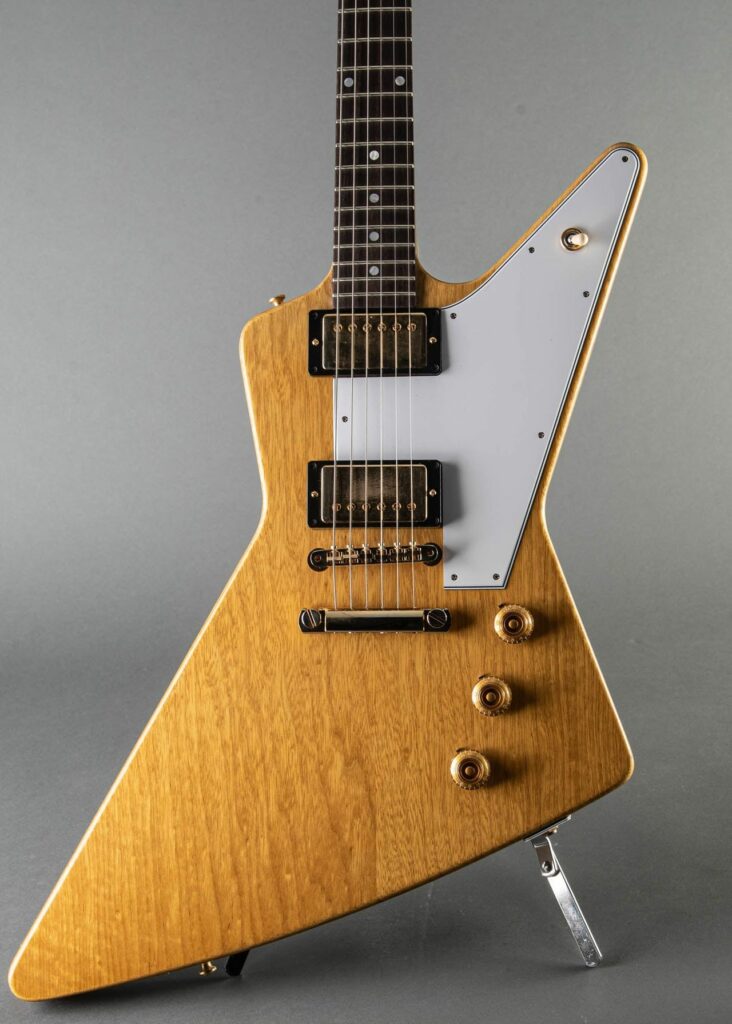
- Number Made: 19
- $611,000
- Manufacturer: Gibson
- Year Produced: 1963 (made from leftover parts from 1958)
Simply because nobody really wanted them when they first came out, the 1958 Gibson Explorer is now considered to be one of the rarest electric guitars that Gibson has ever manufactured.
Rick Nielson of Cheap Trick is said to be the only person in the world who possesses two of these extremely rare Gibson Explorer guitars. In 1958, just about 19 of these Gibson Explorer guitars were produced.
Over half a billion dollars was paid for a 1958 Gibson Explorer when it was sold in 2006 (exactly 611 thousand dollars).
The Gibson Explorer that was sold at auction has its original case and was constructed in 1963 using the bodies and necks that had been left over from the 1958 production run.
6. 1959 Left-handed Gibson Les Paul Standard Sunburst
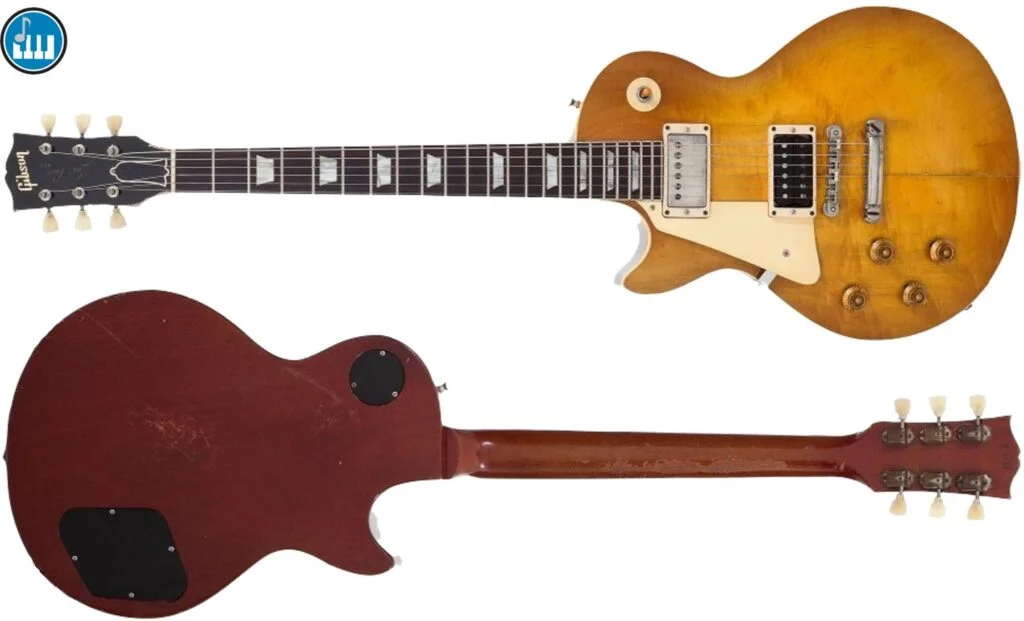
- Number Made: 2
- $194,500
- Manufacturer: Gibson
- Year Produced: 1959
One of the most expensive electric guitars ever sold, a 1959 Left-handed Gibson Les Paul Standard Sunburst fetched $194,500 at auction.
This particular model is one of only two of its kind to have ever been produced. The legendary tennis player John McEnroe once had this one-of-a-kind left-handed electric guitar, and the instrument was featured alongside McEnroe on the cover of a 2009 issue of Guitar Aficionado magazine.
It was thought that this 1959 Left-handed Gibson Les Paul Standard Sunburst was a fake; nevertheless, the specialists at Heritage Auctions determined that the instrument was genuine.
The United States Marshals Service had donated a number of instruments and pieces of equipment, and the money made from selling them was going to help compensate people who had lost money in the Aspen Energy Oil and Gas Investment Scheme. The guitar was one of those instruments.
7. 1964 Vox V251 Guitar Organ Prototype
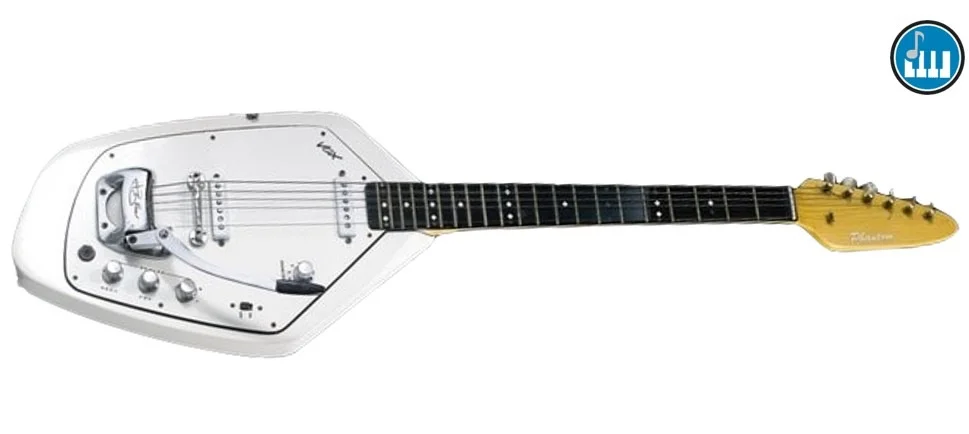
- Number Made: 2
- $305,000
- Manufacturer: Vox (invented by Dick Denney)
- Year Produced: 1964
Anything that is referred to as a prototype is by definition extremely uncommon, and the first two Vox V251 Guitar Organ prototypes are among the rarest electric guitars that have ever been manufactured.
Additionally, anything that is labeled as a prototype is extremely limited in quantity. Dick Denney, a lead engineer at Vox, is credited with developing the company’s V251 Guitar Organ in the early 1960s.
As its name suggests, the Vox Guitar Organ could be played either as a guitar or an organ, either independently or in combination with one another.
John Lennon and Paul McCartney, two members of the band The Beatles, each received a personal presentation from Denney of the first V251 Guitar Organ Prototype.
Despite the fact that they liked the Guitar Organ and decided to keep it, McCartney and Lennon felt that it was too cumbersome and difficult to play.
The V251 Guitar Organ Prototype was later auctioned off for a total of $305,000 after Lennon had given the instrument to the band’s roadie, Mal Evans. According to reports, the Rolling Stones also got their hands on a V251 Guitar Organ Prototype.
8. 1969/1970 Gibson Les Paul Prototype Recording Model
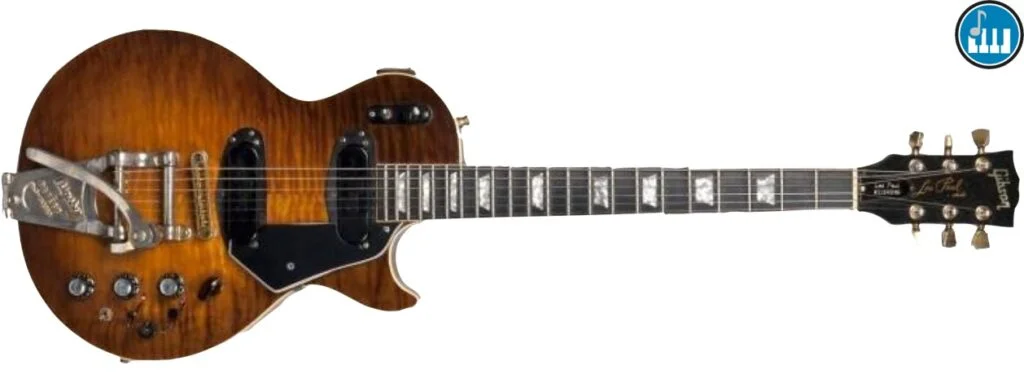
- Number Made: 1
- $187,500
- Manufacturer: Gibson and Les Paul
- Year Produced: 1969 – 1970
Only one Gibson Les Paul Recording model was ever produced between the years 1969 and 1970 because it served as a prototype.
This extremely valuable electric guitar bears the serial number “001” as well as the inscription “Original Gibson Prototype.”
It is thought that this specific Recording model, which was purchased at auction for the price of $187,500, was the very first Les Paul Recording model.
It’s interesting to note that out of all the guitars Les Paul has ever created, his personal favorite is the Recording model.
The Recording model was never successful in the marketplace, and only a few thousand were ever bought. It was only manufactured for roughly eight years, and other than Les Paul himself, the only other prominent artist known to own a Recording model is the musician Jimmy Page.
9. 1954 Original Gibson Les Paul Custom “Black Beauty”
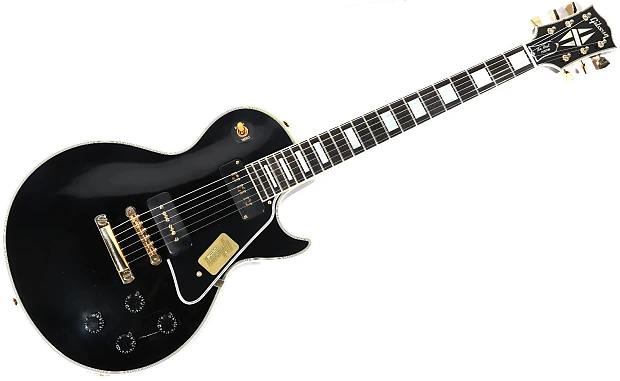
- Number Made: 1
- $343,750
- Manufacturer: Gibson (customized and created by Les Paul)
- Year Produced: 1954
The first Gibson Les Paul, produced in the 1950s and given the nickname “Black Beauty,” is revered within the community of electric guitar players as the “holy grail” of the instrument.
It was the very first example of Gibson’s famed Les Paul model guitar, and it went on to serve as the inspiration for all of the company’s subsequent iterations of the guitar in the series.
Black Beauty is the rarest electric guitar in the world since Les Paul personally owned and worked on it, making it genuinely one of a kind and making it the world’s only example of its sort.
Tom Doyle, who had been Les Paul’s guitar tech, friend, and sound guy, sold Black Beauty at auction in 2015 for the price of $335,500. Doyle was the owner of Black Beauty at the time of the sale. Jim Irsay, owner of the Indianapolis Colts, has acquired an extremely rare electric guitar.
10. 1951 Fender Broadcaster and No-Caster
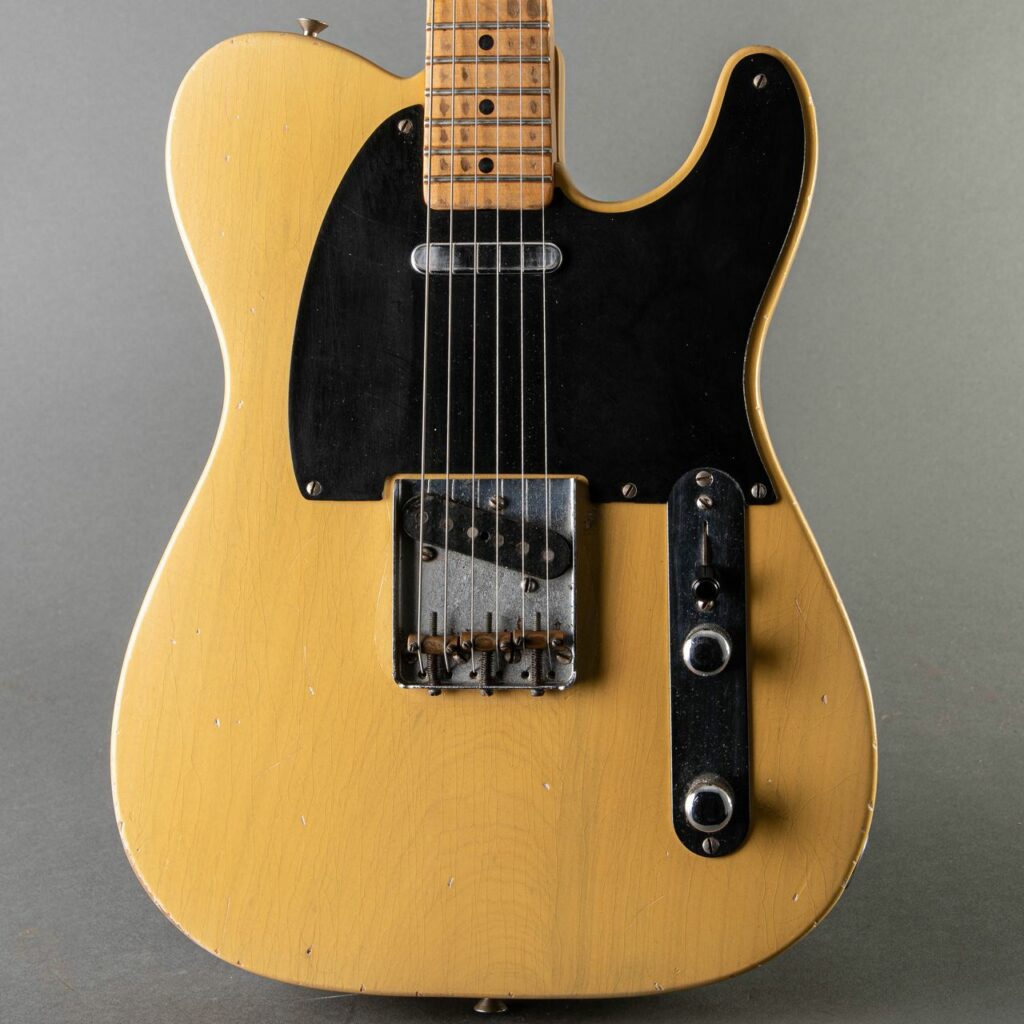
- The approximate number of guitars made: Broadcaster 250 and No-caster 475
- Approximate value based on prices paid at auction: US$60,000
- Manufacturer: Fender
- Year of production: 1951
Fender was the manufacturer, and the year of production was 1951. The approximate number of guitars produced was 250 for the Broadcaster and 475 for the No-caster. The guitars’ combined value was around $60,000 based on the prices they fetched at auction.
Both the 1951 Fender Broadcaster and the “Nocaster” are examples of electric guitars with a fascinating past.
The Broadcaster and the No-Caster were the precursors to the Fender Telecaster, which went on to become the most successful solid-body electric guitar in the history of the instrument.
During the initial production run in 1950, these extremely rare electric guitars were given the name “Broadcaster” at first.
The Gretsch Company, who sold a drum kit called the “Broadkaster,” requested that Fender remove all Broadcaster emblems off the remaining guitars the following year.
In response, Fender stated that they would comply with this request.
Only the Fender emblem appeared on guitars that were marketed throughout the year 1951 until the latter half of that year when the guitars were given their new moniker, the Telecaster.
10 Rarest Electric Guitars in the World – Newshub360.net
Related Post
Credit: www.Newshub360.net
